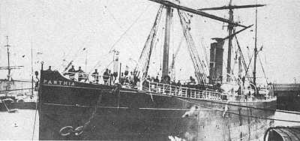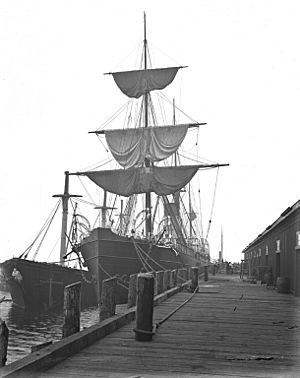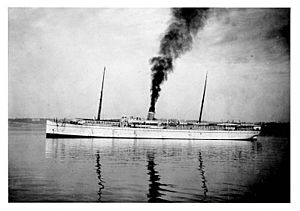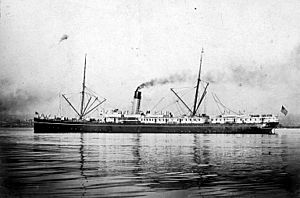SS Parthia (1870) facts for kids
class="infobox " style="float: right; clear: right; width: 315px; border-spacing: 2px; text-align: left; font-size: 90%;" |+SS Parthia/Victoria
| colspan="2" style="text-align: center; font-size: 90%; line-height: 1.5em;" | 
|} The SS Parthia was an amazing ship that sailed the seas for 86 years! Built in 1870, this iron-hulled ocean liner was first known as the Parthia. She was made for the Cunard Line by William Denny and Brothers in Dumbarton, Scotland.
The Parthia was a bit different from her sister ships, the Abyssinia and Algeria. She was smaller and had a slightly different look. In 1883, Cunard sold her. She then sailed for the Guion Line and later for the Canadian Pacific Railway Company. After a big makeover, she was renamed Victoria.
As Victoria, she sailed for new owners like the Northern Pacific Steamship Company. She even became an American ship in 1898. This meant she helped the United States during the Spanish–American War by carrying troops. Later, she became a key ship for the Alaska Steamship Company, traveling to Nome, Alaska.
In 1924, when she was 54 years old, the Victoria got another major upgrade. She looked almost new! She even started carrying tourists on the first Alaskan cruises. After serving in World War II as a cargo ship, she was finally sold in 1952. She was turned into a barge called Straits No. 27 and then Straits Maru. In 1956, she was taken apart in Osaka, Japan, ending her very long and busy life.
Contents
- Life with Cunard Line
- Joining the Guion Line
- Moving to the Pacific Ocean
- Sailing for Alaska Steamship Company
- The Final Years
| History | |
|---|---|
| Name | Parthia |
| Owner |
|
| Operator | |
| Ordered | Late 1860s |
| Builder | William Denny and Brothers in Dumbarton |
| Cost | £94,970 |
| Yard number | 148 |
| Laid down | 2 February 1870 |
| Launched | 10 September 1870 |
| Decommissioned | 1883 (by Cunard) |
| Maiden voyage | 17 December 1870 |
| In service |
|
| Out of service |
|
| Renamed | Victoria |
| Refit | 1892 |
| Fate | Rebuilt and renamed Victoria |
| Name | Victoria |
| Owner |
|
| Operator |
|
| Route |
|
| In service | 1892–98 |
| Out of service | 1892 (was undergoing refit) |
| Fate | Transferred to American registry in 1898 |
| Name | Victoria |
| Owner |
|
| Operator |
|
| Route |
|
| Acquired | 1898 |
| In service |
|
| Out of service |
|
| Renamed | Straits No. 27 |
| Reclassified | Cargo only vessel as of 1940 |
| Refit | 1924 |
| Fate | Converted into a barge in 1954 |
| Notes | Extensive refit in 1924, converted to oil fired boilers, raised superstructure and enclosed bridge to the ship's hull. |
| Name | Straits No. 27 |
| Owner |
|
| Operator |
|
| Commissioned | 1954 |
| Decommissioned | 1956 |
| In service | 1954–56 |
| Renamed | Straits Maru |
| Fate | Sold to Japanese ship breakers |
| Name | Straits Maru |
| Owner | Japanese ship breakers |
| Port of registry | Osaka |
| Fate | Scrapped at Osaka in 1956 |
| General characteristics | |
| Type |
|
| Tonnage | 3,167 GRT |
| Length | 360.5 ft (110 m) |
| Beam | 40.3 ft (12 m) |
| Propulsion | Compound steam engines driving a single screw propeller. Re-engined with Triple-expansion steam engines in 1885. |
| Sail plan | Barque (as Parthia) |
| Speed | 13 knots |
| Capacity | 200 First Class Passengers and 1,050 Third Class Passengers (as Parthia) |
The Ship's Beginning
After a rival company went out of business, the Cunard Line became the biggest shipping company on the Atlantic Ocean. In the late 1860s, Cunard decided to build three new, modern ships. These ships would help them keep their top spot.
The new ships were designed with flat decks and an open bridge. They would have three masts with barque rig sails and one funnel. They were also special because they were the first Cunard ships to have bathrooms!
The first two ships, Abyssinia and Algeria, were built in Glasgow. The third ship, the Parthia, was the smallest. She was built at William Denny and Brothers in Dumbarton. Her construction started on February 2, 1870. Just over seven months later, on September 10, the Parthia's hull was launched into the water. She was finished a few months after that. Building her cost about £94,970.
Life with Cunard Line
On December 17, 1870, the Parthia began her first journey. She sailed from Liverpool to New York City. The Parthia could travel at 13 knots, which was a good speed. However, she wasn't fast enough to win the "Blue Riband" award for the fastest Atlantic crossing. That award was held by another Cunard ship, the Scotia.
Even so, the Parthia was a great ship. She quickly became one of the best ships in Cunard's fleet. She was more efficient than her larger sister ships. This meant she used less coal and had more space for cargo. She also had a slightly thinner funnel than her sisters.
In 1871, Cunard got new competition from the White Star Line. Their new ship, the Oceanic, was bigger and had fancier passenger areas than the Parthia. Despite this, the Parthia continued to do well.
The Parthia had a few minor bumps during her time. In 1872, she bumped into another ship, the Nina, in the River Mersey. In 1874, she had a small collision with White Star's Adriatic near New York. The Parthia was barely damaged. She also helped other ships in trouble. In 1880, she tried to tow a sinking ship called Mary A. Marshall. The Marshall sank, but her crew was saved. Later that year, the Parthia rescued the crew of the sunken James Edwards.
By the time she was nine years old, the Parthia was becoming old-fashioned. Newer, faster ships were being built. On October 27, 1881, she had a special job. She was used to carry troops during the Mahdist War. The next year, she ran aground while trying to avoid another ship.
Joining the Guion Line
In November 1883, the Parthia made her last trip for Cunard. After returning to Liverpool, she was put aside. Cunard sold the Parthia to John Elder & Co. in 1884. This helped Cunard pay for new, faster ships.
The owner of John Elder & Co. also owned the Guion Line. He planned for the Parthia to carry passengers and livestock from Glasgow to Canada. To get ready, the Parthia got new, more efficient engines. These new engines almost cut her coal use in half!
Before starting her new job, the Parthia was again used to carry troops for a short time. After that, the Guion Line rented her out to another company. She carried immigrants from Sydney to Yokohama. Later, she sailed for the Guion Line from Australia to South America.
Moving to the Pacific Ocean
In 1887, the Guion Line rented the Parthia to the Canadian Pacific Railway Company. This company used her to start their new service across the Pacific Ocean. They needed a ship while they waited for their own new ships to be built. This Pacific service was meant to connect their railway line to eastern Asia.
The Parthia arrived in Vancouver, British Columbia, on July 4. She then began her trips across the Pacific. She made 20 voyages for Canadian Pacific between 1887 and 1891. After that, she went back to the Guion Line. Canadian Pacific was getting new "Empress" ships that would carry mail and could also be used in wartime.
The Guion Line sent the Parthia back to John Elder & Co. There, the ship had a huge makeover. After this big refit, she only had two masts and was given a new name: Victoria. The Guion Line then sold the Victoria to the Northern Pacific Steamship Company. This company used her to sail between Hong Kong and Tacoma, Washington.
After only six years, the Victoria was sold again. This time, she went to the North American Mail Steamship Company. She also became an American-registered ship.
In 1899, the U.S. Government used the Victoria as a troopship during the Spanish–American War. She made six trips carrying troops between the United States and Manila in the Philippines. Then she was returned to her owners. In 1900, the Victoria sailed from the Puget Sound to Nome, Alaska. She carried many gold seekers during the Klondike Gold Rush.
In 1901, she was sold back to the Northern Pacific Steamship Company. Three years later, she was sold again to the Northwestern Steamship Company. Under this new owner, she started sailing regularly to Alaska. The Victoria's strong, iron hull was great for breaking through ice. In 1905, she even helped a port in Russia during the Russo-Japanese War.
Sailing for Alaska Steamship Company
In 1908, the Alaska Steamship Company bought the Northwestern Steamship Company. The Victoria was now 38 years old, but her new owners still thought she was very important. Her route changed to sail between Nome and San Francisco, California, with a stop in Seattle, Washington. In 1910, the Victoria almost ran aground in Alaska, near where another ship had sunk a few years before.
During World War I, the Victoria carried a lot of cargo across the Pacific. This earned her owners a lot of money. Using this money, the Victoria had a huge refit in 1924. Her upper decks were made bigger and taller. She got extra decks, and her bridge was fully enclosed to protect from the weather. Her engines and boilers were also changed to burn oil instead of coal. Even though she was 54 years old, the Victoria looked like a brand new ship!
In 1927, one of the Victoria's engine parts broke. A U.S. Coast Guard ship had to tow her to Akutan, Alaska. In 1934, the Victoria made history. She started the first Alaskan cruise for the Alaska Steamship Company. She visited Nome and Kotzebue, Alaska. She even sailed close to an Arctic ice cap near Wrangell Island in Siberia.
The Final Years
By 1935, the Victoria's long life was nearing its end. She spent three years docked in Lake Union. This was because of new safety rules from the U.S. Government. After sailing briefly for two more years, the Victoria was changed to carry only cargo in 1940.
When the United States joined World War II, the U.S. government used the Victoria. From 1942 to 1947, she made 46 trips to Alaska. When she was returned to the Alaska Steamship Company, her hull was still in great shape. In 1950, the Victoria's bell was given back to the Cunard Line. It was used on their new ship, the second Parthia. The Victoria continued to serve until 1952. By then, she had been sailing for almost 80 years!
In 1954, the Victoria was sold to a company called Dulien Steel Products to be taken apart. But the company realized how strong she still was. So, in 1955, they sold her to the Straits Towing and Salvage Company in Vancouver. She was turned into a barge for carrying lumber and was named Straits No. 27. The next year, she was sold to companies in Japan that break up old ships. She was renamed Straits Maru for her very last journey. A tugboat towed her to Osaka, where she was finally taken apart in 1956. The former Parthia had reached the amazing age of 86 years!
Images for kids












